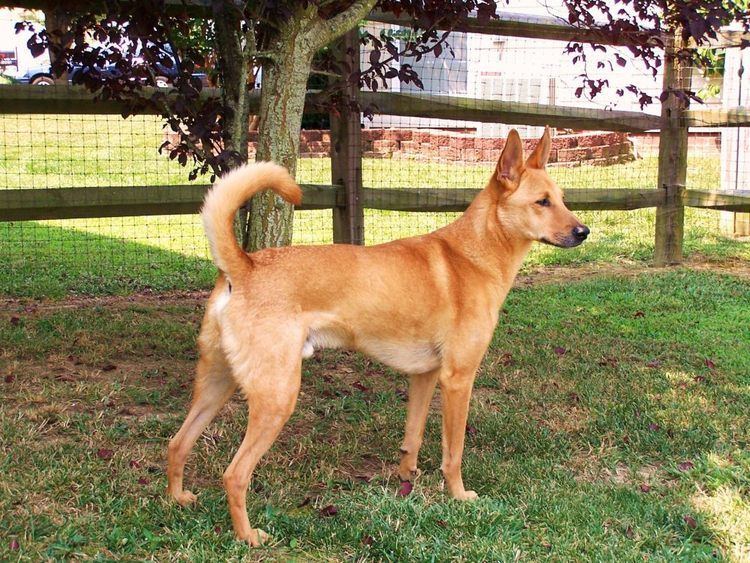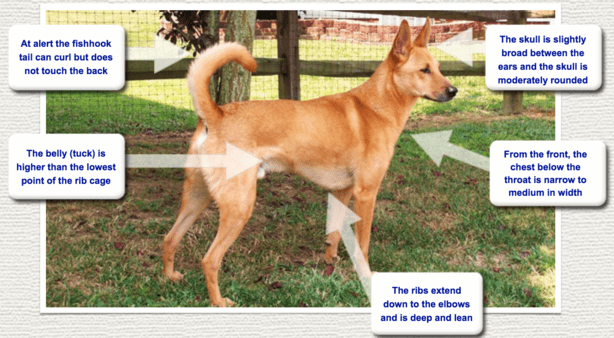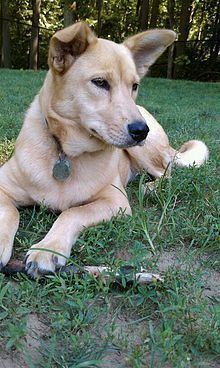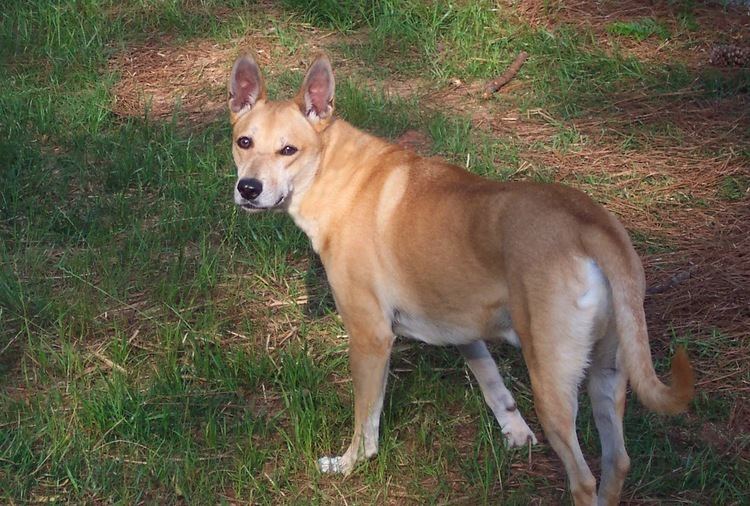Weight 30–44 lb (14–20 kg) Scientific name Canis lupus familiaris Mass 15 – 20 kg | UKC Sighthound & Pariah Height 45 – 61 cm Origin United States of America | |
Colour Preferable: red ginger with pale buff markings over the shoulders, and pale white along the muzzle. Temperament Reserved, Adaptable, Gentle, Loyal, Primitive Colors Red Ginger, Yellow, Beige, Red Sable, Tan, Orange Similar Chinook, Canaan Dog, American English Coonhound, American Water Spaniel, American Hairless Terrier | ||
Carolina dog rare breed nicknamed the american dingo
The Carolina Dog was originally a landrace or naturally selected type of dog which was rediscovered living as a wild dog or free roaming dog by Dr. I. Lehr Brisbin, and originally documented in American dog breed publications in the 1920s. Carolina Dogs often live in isolated stretches of longleaf pines and cypress swamps in the Southeastern United States. A breed standard has been developed by the United Kennel Club that now specifies the appearance of these dogs. Carolina Dogs are a medium sized dog, that comes in varying shades of red ginger, buff, fawn, black, black and tan or piebald with or without small white markings on toes, chest, tail tip and muzzle. Frequently puppies have a melanistic mask that usually fades as the adult coat comes in.
Contents
- Carolina dog rare breed nicknamed the american dingo
- Our carolina dog american dingo mov
- Discovery
- Physical
- Behavior
- Temperament
- DNA testing
- Breed recognition and domestication
- References

Our carolina dog american dingo mov
Discovery

One of the earliest publications to document Carolina Dogs was the article "Dogs of the American Aborigines" by Glover Morrill Allen, published in 1920 by the Museum of Comparative Zoology at Harvard College. Allen postulated that these "Larger or Common Indian Dogs" were descended from Asian primitive dogs: "The probability therefore is, that the Domestic Dog originated in Asia and was carried by primitive man both east and west into all parts of the inhabited world. That this migration began in late Pleistocene times seems highly probable." Allen cites late 19th century studies of skeletal remains of these dogs excavated from Indian mounds as well:

Cope (1893) was the first to describe the jaw of this dog from a specimen collected by Moore from a shell-mound on St. John's River, Florida. He was struck by the fact that the first lower premolar was missing and appeared not to have developed. The strong development of the entoconid of the carnassial, he also noticed. Moore, in the course of various explorations in Florida and Georgia discovered many remains of dogs, apparently of this type. In a large mound on Ossabaw Island, Georgia, he (1897) found several interments of human and dog-skeletons, the latter always buried sepa rately and entire, showing that the dogs had not been used as food. Other dog-skeletons of a similar sort were found by Moore (1899) in aboriginal mounds on the South Carolina coast.

Later in the 20th century these dogs were rediscovered by Dr. I. Lehr Brisbin Jr., a Senior Research Ecologist at the University of Georgia's Savannah River Ecology Lab, who first came across a Carolina Dog while working at the Savannah River Site.

Horace, a ginger piebald (white with brown markings) stray, was wandering the site's boundary when he caught Brisbin’s attention. Brisbin, who had seen many rural dogs chained to the back of porches and doghouses, assumed this was just a normal stray. Many of these dogs roamed the woods and would turn up in humane traps, and Brisbin began to wonder how many more of these were in the wild. On a hunch, he went to the pound and was surprised by the resemblance the dog had to dingos.
Physical

The ears are large and erect and can be individually turned to the direction of the sound. Height: 17-24 inches (45–61 cm.) Weight: 30-65 pounds (15–20 kg.)
Behavior
Female dogs had three estrus cycles in quick succession, which settled into seasonal reproductive cycles when there was an abundance of puppies. Brisbin noted that this was most likely to ensure quick breeding before diseases, like heartworm, take their toll. Some pregnant dogs also dug dens in which to give birth.
After they gave birth or while pregnant, the dog would carefully push sand with her snout to cover her excrement. They were excellent at locating and catching small mammals e.g. shrews and mice, using a pouncing technique similar to a fox. The dogs also dug “snout pits”, or hundreds of tiny holes in the dirt that perfectly fit their muzzles during this time. More female dogs dug them than males.
In the wild, Carolina Dogs often live in sparsely settled land instead of the highly populated areas stray dogs commonly occupied. However there are sizeable wild populations in metro Atlanta's wooded areas even near industrial plants and major highways. More study is required to accurately document their habitat behaviors.
Carolina Dogs were first noted on the Savannah River Site which by design was depopulated and secured of all trespass and traffic for decades beginning in 1950. The Savannah River Site was also one of two sites secluding South Carolina's deer population at the time of the discovery of the Carolina dog.
Temperament
Carolina Dogs are natural runners. They have excellent noses that help them hunt wild animals, when in the wild. When kept as pets, the breed requires moderate exercise and sufficient space. They need to be exposed to a lot of social activity from a young age. Once they are trained enough, they are said to make excellent family dogs.
DNA testing
It was proposed that Mitochondrial DNA testing might prove a link between primitive dogs and Carolina dogs. Brisbin stated, "We grabbed them out of the woods based on what they look like, and if they were just dogs their DNA patterns should be well distributed throughout the canine family tree. But they aren't. They're all at the base of the tree, where you would find very primitive dogs." This was not conclusive, but it did spark interest into more extensive DNA testing.
In 2013, a study looked at the mDNA haplotypes associated with samples of the Carolina dog. The study showed that 58% of the dogs carried universal haplotypes that could be found around the world (haplotypes A16, A18, A19, and B1), 5% carried haplotypes associated with Korea and Japan (A39), and 37% carried a unique haplotype that was not recorded before (A184) and that relates to the a5 mDNA sub-haplogroup that originated in East Asia. As the dingo and the New Guinea singing dog belong to haplotype A29 that relates to the a2 sub-haplogroup, there is no genetic relationship.
In the same year, a study of several dog breeds in the Americas — among them the Peruvian hairless, the Chihuahua and the Carolina dog indicated a migration from Asia.
In 2015, a large-scale survey of autosomal, mitochondrial, and Y-chromosome diversity in 4,676 purebred dogs from 161 breeds and 549 village dogs from 38 countries was conducted. Testing for the degree of admixture with European dogs, the study found no yDNA haplotypes in indigenous North American dogs outside of the Arctic, however the mDNA of Carolina dogs contained between 10% and 35% pre-Columbian ancestry (mDNA haplotype A184) that clustered with East Asia.
Breed recognition and domestication
Carolina Dogs can be registered with the American Rare Breed Association and the United Kennel Club. ARBA includes the breed in its "Spitz and Primitive Group", which includes primitives such as the dingo and Canaan Dog. The UKC has classified them as a pariah dog, a class which includes other primitive breeds such as the Basenji of Africa and the Thai Ridgeback.
